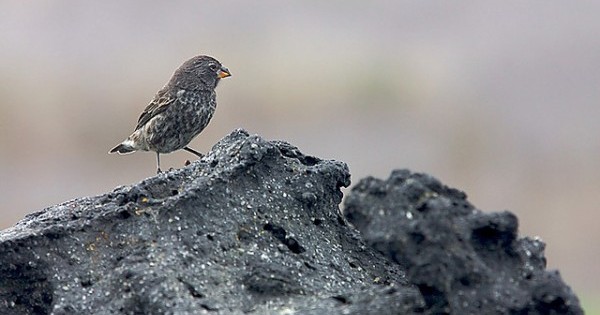
Natural selection operates passively, while nobody is looking. Or rather, while nobody used to be looking. Any given species eats, reproduces, and dies within its ecological home. Like life itself, environments never stop changing, and sometimes a shift in the environment distresses some individual members of a species to the point of death. Others survive to reproduce and pass to their offspring whatever trait (if heritable) allowed them to survive the emergency. Through the generations, the lucky trait (lucky for the moment) spreads through the population.
Any non-cloned population contains variations among individual members. These variations can be downright minuscule. Natural selection, which works through the channel of individuals of reproductive age, does not, by itself, result in evolution by means of natural selection. Nature can “select” an individual to survive. But an individual so selected will have no effect on the evolution of the species if he or she produces no offspring.
This brings us to Darwin’s famous finches. In The Voyage of the Beagle Charles Darwin wrote of the “curious Finches” he’d seen and collected in 1835 on the Galápagos Islands, located in the Pacific Ocean 600 miles west of Ecuador (Darwin’s “Republic of the Equator”). In this volcanic landscape there existed, Darwin wrote, “a most singular group of finches, related to each other in the structure of their beaks, short tails, form of body and plumage.” Of their huge variety of beaks he wrote: “Seeing this gradation and diversity of structure in one small, intimately related group of birds, one might really fancy that from an original paucity of birds in this archipelago, one species had been taken and modified for different ends.” Darwin worked with no knowledge of genetics, but in terms of today’s science his educated guess was exactly right. Darwin’s finches (subfamily Geospizinae) exist in 14 or 15 monophyletic species—monophyletic meaning that all species of Galápagos finches evolved from one species. This happened two million or more years ago.
In 1973, Princeton University evolutionary biologists Peter and Rosemary Grant began counting, tagging, weighing, and measuring the Galápagos finches, and measuring the seeds, bugs, and fruits they ate. Their work is the subject of a transcendent work of science and natural history, The Beak of the Finch, by Jonathan Weiner. More recently and to a greater degree of complexity (but with pristine clarity), the Grants elaborated their work for a broad readership in How and Why Species Multiply: The Radiation of Darwin’s Finches.
Islands situated far out to sea make good laboratories for population studies because island inhabitants are stuck there. Islands isolate species. On the Galápagos the finches were numerous, but their number was finite. The Grants and their fellow researchers were able to tag and follow virtually every member of certain populations, generation after generation. Each year they made thousands of measurements and then, upon their return to Princeton, computer-crunched the numbers.
They began their work during the rainy season of 1973, when vegetation was lush and seeds were plentiful. At first they could find no correlation between a bird’s beak type and the type of seed it ate. The seed menu was ample and the finches all partook of the smorgasbord, except that smaller-beaked birds couldn’t crack open the hardest seedpods. But, so what? There appeared to be no hint that any finch had evolved a particular type of beak good for grasping and cracking open a particular type of seed.
But then the Grants returned during the dry season when there were many fewer seeds of any kind. Competition for food was intense, and now the finches were eating seeds suited to their beak type. (If two species occupy the same food niche and some individuals can eat a subset of the menu inaccessible to others, its species may evolve to occupy the food niche that is free of competition.)
Years passed. Birds were counted, measurements taken. Then came what became known as the “selection event of 1977.” A severe drought. The rainy season brought no rain. Plants dried up. The finches pecked the scorched volcanic earth in a desperate search for seeds. The total number of seeds declined and the available seeds were harder, larger ones that smaller-beaked birds could not crack open. Finches died in droves. On the island Daphne Major, in March 1976, the total number of finches was 1,400. By December 1977, fewer than 300 remained. The survivors were the larger birds with the beaks—both deep and narrow—better able to crack open the hardest seedpods. It was, writes Weiner, “the most intense episode of natural selection ever documented in nature.”
Here was natural selection occuring not over the slow eons, as Darwin and his contemporaries and scions assumed it must, but in a few short seasons before the very eyes of the Grants and their co-researchers.
How much bigger were the beaks of the survivors? About one-half a millimeter. Consider that a lentil is an enormous four millimeters wide. To the finches, a half millimeter made the difference between life and death.
Now that they had survived, would these bigger birds be able to pass to their offspring their bigger bodies and bigger beaks?
Yes they would. After survival, sex. After natural selection, sexual selection. A majority of the survivors were male, since during the drought their larger size had given them an advantage. In finch society during breeding season, the male builds a nest and sings. The female chooses her mate.
In the seasons following the great drought, with rain levels back to normal, among G. fortis, the medium ground finch on Daphne Major, the females consistently selected the biggest males with the blackest feathers and the strongest beaks. Over the next few generations, the entire population of G. fortis grew larger, with stronger beaks.
And there you have it. Evolution through natural selection.

